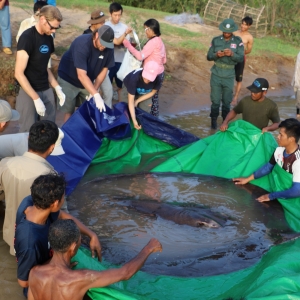Welcome to “What’s Up With Water” – your need-to-know news of the world’s water from Circle of Blue. I’m Eileen Wray-McCann.
In the United States, the holiday season was marked by winter storms that showed how vulnerable water systems are to extreme weather. Cold winters are unusual in the American South, but temperatures dipped below freezing in Alabama, Louisiana, Mississippi, and South Carolina. This cold plunge, especially in the Deep South, caused pipes to freeze, burst, and leak. Millions of gallons of water were spilled across the region, according to Al Jazeera. Over the Christmas weekend, the water treatment plant in Charleston, South Carolina, produced double the usual amount of water. City officials attributed the surge in water demand to leaking pipes. Towns in Kentucky were without water for days, according to the news station WYMT. And in Jackson, Mississippi, dozens of burst pipes added to a difficult year for the state’s capital city. Its water treatment plant failed in August during heavy rain, leaving 180,000 residents without tap water for days. Ahead of the new year, Jackson had another boil-water notice due to burst pipes.
California has also been battered by winter storms. Plumes of intense rain and snow hit the state last week, raising concerns about flooding and landslides in areas that are recovering from wildfires. California has had three consecutive dry years, so the moisture is needed to replenish reservoirs. But even with the storms, the state has a long-term water supply problem, shown in a new study based on satellite data. According to the study, California’s groundwater extraction has already exceeded what nature provides, and it accelerated in the Central Valley during the current drought. The Central Valley is one of the country’s most productive farming regions. In wet years, irrigation water comes from rivers. In dry years, though, farmers pump water from underground. The satellite data suggests that excessive pumping is taxing the groundwater system. Between 2019 and 2021, groundwater depletion was five times higher than average over the previous 60 years. There are consequences when groundwater is depleted. Thousands of household wells have gone dry and the land in some areas is sinking. Roads and canals have been damaged by the land subsidence, costing hundreds of millions of dollars to repair. California lawmakers intend to bring supply and demand back into balance. They passed a bill in 2014 that requires groundwater basins to be sustainably managed. However, it is not a quick fix. Water managers have until 2040 to meet the requirements. The authors of the satellite study say that timeline is too slow. They argue that the state’s groundwater depletion is a major economic, environmental, and social risk that demands a faster response.
Water shortages, weather disasters, and climate instability are uprooting people from their homes. For the first time, U.S. officials have an idea about how many people are being displaced. New data from the Census Bureau indicates that some 3 million people in the country were displaced by weather disasters in the last year. According to the Associate Press, about half of the affected people left home due to hurricanes. Being displaced could mean finding a hotel room to ride out the storm. Or it could mean living in a temporary trailer because your home was damaged. Displacement was most widespread in Louisiana, where 15 percent of the state’s residents left home last year because of a weather disaster. People who were displaced tended to be poorer than the average American. Most people were able to return home within a week. But for some, the dislocation was permanent. About one in six residents who were displaced moved elsewhere after the storm.
And that’s What’s Up With Water from Circle of Blue, where water speaks. You’ll find more news and analysis – and a chance to support our work – at
circleofblue.org. This is Eileen Wray-McCann – thanks for being here.






